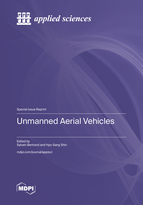Unmanned Aerial Vehicles
A special issue of Applied Sciences (ISSN 2076-3417). This special issue belongs to the section "Aerospace Science and Engineering".
Deadline for manuscript submissions: closed (20 May 2022) | Viewed by 67655
Special Issue Editors
Interests: unmanned aerial vehicles; autonomous and multi-agent systems; control systems; probabilistic risk assessment; applications to robotic and aerospace systems
Special Issues, Collections and Topics in MDPI journals
Interests: unmanned aerial vehicles; decision making on multi-agent systems; distributed sensing and estimation; data-centric guidance and control
Special Issues, Collections and Topics in MDPI journals
Special Issue Information
Dear Colleagues,
Unmanned aerial vehicles (UAVs) are now recognized as very useful tools to replace, help, or assist humans in various missions, such as inspection and monitoring, surveillance, search and rescue, exploration, logistics and transportation, etc. Practical uses for such missions in both civilian and defense contexts have experienced a significant growth thanks to recent technological progresses. Nevertheless, some challenges and open issues remain to ensure the full operational use of UAVs.
This Special Issue aims to present recent advances in technologies and algorithms to improve the levels of autonomy, reliability, and safety of UAVs. Topics of interest include but are not limited to: advanced guidance, navigation, and control algorithms; autonomy and decision-making; perception and multi-sensor fusion for robust navigation; networked swarms; unmanned aerial system traffic management (UTM); new vehicle concepts and designs; smart sensors for UAVs; new applications and field experiments; reliability, safety, and risk assessment.
Dr. Sylvain Bertrand
Prof. Dr. Hyo-Sang Shin
Guest Editors
Manuscript Submission Information
Manuscripts should be submitted online at www.mdpi.com by registering and logging in to this website. Once you are registered, click here to go to the submission form. Manuscripts can be submitted until the deadline. All submissions that pass pre-check are peer-reviewed. Accepted papers will be published continuously in the journal (as soon as accepted) and will be listed together on the special issue website. Research articles, review articles as well as short communications are invited. For planned papers, a title and short abstract (about 100 words) can be sent to the Editorial Office for announcement on this website.
Submitted manuscripts should not have been published previously, nor be under consideration for publication elsewhere (except conference proceedings papers). All manuscripts are thoroughly refereed through a single-blind peer-review process. A guide for authors and other relevant information for submission of manuscripts is available on the Instructions for Authors page. Applied Sciences is an international peer-reviewed open access semimonthly journal published by MDPI.
Please visit the Instructions for Authors page before submitting a manuscript. The Article Processing Charge (APC) for publication in this open access journal is 2400 CHF (Swiss Francs). Submitted papers should be well formatted and use good English. Authors may use MDPI's English editing service prior to publication or during author revisions.
Keywords
- Unmanned aerial vehicles
- Unmanned aerial system traffic management
- Guidance, navigation, and control
- Autonomy, perception, decision-making
- Multiple-agent systems
- Networked swarms
- Reliability, safety, risk assessment







